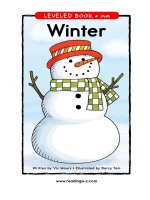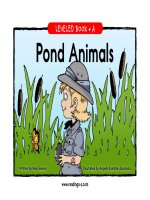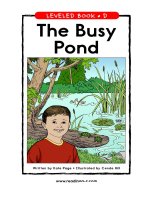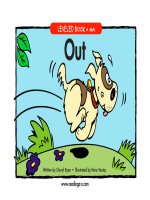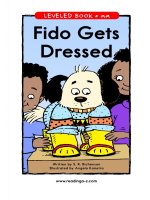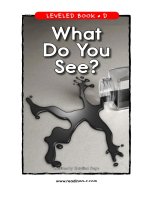raz ll08 crocsandgators
Bạn đang xem bản rút gọn của tài liệu. Xem và tải ngay bản đầy đủ của tài liệu tại đây (1.64 MB, 18 trang )
LEVELED BOOK • L
Crocs and Gators
Written by Kira Freed
www.readinga-z.com
Crocs and Gators
A Reading A–Z Level L Leveled Book • Word Count: 600
Visit
www.readinga-z.com for thousands of books and materials.
Photo Credits:
Front cover, back cover, all pages (except page 15): © ArtToday; page 15: © REUTERS/Tomas Bravo/Landov
Crocs and Gators
Level L Leveled Book
© Learning A–Z
Written by Kira Freed
All rights reserved.
www.readinga-z.com
Correlation
LEVEL L
Fountas & Pinnell
Reading Recovery
DRA
K
18
20
www.readinga-z.com
Written by Kira Freed
Crocs and Gators
Caiman
Crocodiles and alligators—like snakes, turtles, and
lizards—are reptiles. They are members of a group
of reptiles called crocodilians. Crocodilians have been
on Earth since the age of dinosaurs. They even look
a little like some of the dinosaurs from long ago.
4
Crocs and Gators • Level L
3
Never smile at a crocodile. That’s what the song from
the movie Peter Pan says. After all, one bit off Captain
Hook’s hand. Everyone thinks that crocodiles are
fierce animals. And, in fact, they are.
Alligator ready to attack
Caiman
Crocodiles and alligators—like snakes, turtles, and
lizards—are reptiles. They are members of a group
of reptiles called crocodilians. Crocodilians have been
on Earth since the age of dinosaurs. They even look
a little like some of the dinosaurs from long ago.
4
Crocs and Gators • Level L
Never smile at a crocodile. That’s what the song from
the movie Peter Pan says. After all, one bit off Captain
Hook’s hand. Everyone thinks that crocodiles are
fierce animals. And, in fact, they are.
Alligator ready to attack
3
Alligator
Crocodilians spend time on land and in water. They use
lungs to breathe. They have thick, scaly skin. Their body
temperature does not stay the same like yours does. Instead,
it changes with the temperature of the air and water around
them. If it is too hot, these reptiles seek cool, shady places.
Crocs and Gators • Level L
5
6
Crocodilians live mostly in shallow water, swamps, and slow
rivers. Most live in fresh water. But there are saltwater
crocodiles, too. In fact, the saltwater crocodile may be the
biggest reptile. Some reach lengths of over 7 meters (23 ft).
Alligator
Alligator
Crocodilians spend time on land and in water. They use
lungs to breathe. They have thick, scaly skin. Their body
temperature does not stay the same like yours does. Instead,
it changes with the temperature of the air and water around
them. If it is too hot, these reptiles seek cool, shady places.
Crocs and Gators • Level L
5
6
Crocodilians live mostly in shallow water, swamps, and slow
rivers. Most live in fresh water. But there are saltwater
crocodiles, too. In fact, the saltwater crocodile may be the
biggest reptile. Some reach lengths of over 7 meters (23 ft).
Alligator
Alligators
All crocodilians have short legs, and long bodies and tails.
The four kinds of crocodilians have different kinds of jaws
and teeth. All of them have sharp teeth. Let’s meet the
different kinds of crocodilians.
7
Crocs and Gators • Level L
8
Alligators have short, broad snouts. Crocodiles have
narrower snouts than alligators. They also have two
large teeth that stick out. The drawings on this page
show what alligators and crocodiles look like.
Alligator
Crocodile
Alligators
All crocodilians have short legs, and long bodies and tails.
The four kinds of crocodilians have different kinds of jaws
and teeth. All of them have sharp teeth. Let’s meet the
different kinds of crocodilians.
Crocs and Gators • Level L
7
8
Alligators have short, broad snouts. Crocodiles have
narrower snouts than alligators. They also have two
large teeth that stick out. The drawings on this page
show what alligators and crocodiles look like.
Alligator
Crocodile
Crocodilians are hard
to see in water. Only
the tops of their head
and back show. They
often look like a floating
log. While they are
swimming, their eyes
and nostrils stick out
of the water. They can still
see and breathe when they
are mostly underwater.
Crocodile with eyes and nostrils out of the water
10
9
Crocs and Gators • Level L
Caimans live in Central and South America. The shape of their
head is similar to that of a crocodile. Gharials are fish-eaters that
live in India. They have long, narrow snouts. The drawings on
this page show what caimans and gharials look like.
Caiman
Gharial
Crocodilians are hard
to see in water. Only
the tops of their head
and back show. They
often look like a floating
log. While they are
swimming, their eyes
and nostrils stick out
of the water. They can still
see and breathe when they
are mostly underwater.
Crocodile with eyes and nostrils out of the water
10
9
Crocs and Gators • Level L
Caimans live in Central and South America. The shape of their
head is similar to that of a crocodile. Gharials are fish-eaters that
live in India. They have long, narrow snouts. The drawings on
this page show what caimans and gharials look like.
Caiman
Gharial
Crocodilians are fierce
hunters. They use strong
jaws to capture their prey.
They eat animals as big as
deer and cattle, and as small
as fish and birds. They also
will attack people. They
cannot chew their food.
They either swallow it whole
or tear it apart. Sometimes
they drag an animal
underwater to drown it.
Crocodilians have powerful jaws.
12
11
Crocs and Gators • Level L
Crocodilians use large, powerful tails and webbed feet to
move through water. When underwater, they close their ears and
nostrils so that water stays out. They can also shut off
their windpipe. This allows them to open their mouth
without breathing in water.
Crocodilians are good swimmers.
Crocodilians are fierce
hunters. They use strong
jaws to capture their prey.
They eat animals as big as
deer and cattle, and as small
as fish and birds. They also
will attack people. They
cannot chew their food.
They either swallow it whole
or tear it apart. Sometimes
they drag an animal
underwater to drown it.
Crocodilians have powerful jaws.
12
Crocs and Gators • Level L
11
Crocodilians use large, powerful tails and webbed feet to
move through water. When underwater, they close their ears and
nostrils so that water stays out. They can also shut off
their windpipe. This allows them to open their mouth
without breathing in water.
Crocodilians are good swimmers.
Crocodilians lay eggs on land.
Some crocodilians lay their eggs in sand. Others make
a nest with soil and plants. Newly hatched babies
are mostly helpless. Many get eaten by other animals.
The lucky ones have Mom to protect them after
they hatch. Babies grow quickly. They are adults
by the time they are 5 to 8 years old.
14
Crocs and Gators • Level L
13
Crocodilians are very fierce fighters. When a crocodilian attacks,
it is almost impossible to escape. But they have their enemies,
too. They may be killed in a fight with a leopard or lion.
A crocodile eats a frog for lunch.
Crocodilians lay eggs on land.
Some crocodilians lay their eggs in sand. Others make
a nest with soil and plants. Newly hatched babies
are mostly helpless. Many get eaten by other animals.
The lucky ones have Mom to protect them after
they hatch. Babies grow quickly. They are adults
by the time they are 5 to 8 years old.
14
Crocs and Gators • Level L
13
Crocodilians are very fierce fighters. When a crocodilian attacks,
it is almost impossible to escape. But they have their enemies,
too. They may be killed in a fight with a leopard or lion.
A crocodile eats a frog for lunch.
Crocodilian skin
Most crocodilians are endangered. In many parts of the world,
people kill crocodilians for food and for their skins. Farmers
destroy their homes to create land for growing crops and
grazing animals. Crocodilians are also captured for use in
wildlife parks. They are often killed when they grow too big.
Crocs and Gators • Level L
15
16
Around the world, people are helping to protect crocodilians.
They put eggs in incubators to keep them safe. People then
care for the babies until they grow strong enough to survive
in the wild. Protecting them helps to keep nature in balance.
A baby crocodilian gets special care.
Crocodilian skin
Most crocodilians are endangered. In many parts of the world,
people kill crocodilians for food and for their skins. Farmers
destroy their homes to create land for growing crops and
grazing animals. Crocodilians are also captured for use in
wildlife parks. They are often killed when they grow too big.
Crocs and Gators • Level L
15
16
Around the world, people are helping to protect crocodilians.
They put eggs in incubators to keep them safe. People then
care for the babies until they grow strong enough to survive
in the wild. Protecting them helps to keep nature in balance.
A baby crocodilian gets special care.
LEVELED BOOK • L
Crocs and Gators
Written by Kira Freed
www.readinga-z.com
Crocs and Gators
A Reading A–Z Level L Leveled Book • Word Count: 600
Visit
www.readinga-z.com for thousands of books and materials.
Photo Credits:
Front cover, back cover, all pages (except page 15): © ArtToday; page 15: © REUTERS/Tomas Bravo/Landov
Crocs and Gators
Level L Leveled Book
© Learning A–Z
Written by Kira Freed
All rights reserved.
www.readinga-z.com
Correlation
LEVEL L
Fountas & Pinnell
Reading Recovery
DRA
K
18
20
www.readinga-z.com
Written by Kira Freed
Crocs and Gators


